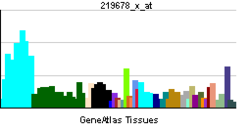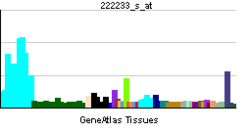- DCLRE1C
-
DNA cross-link repair 1C Identifiers Symbols DCLRE1C; A-SCID; DCLREC1C; FLJ11360; FLJ36438; RS-SCID; SCIDA; SNM1C; hSNM1C External IDs OMIM: 605988 MGI: 2441769 HomoloGene: 32547 GeneCards: DCLRE1C Gene Gene Ontology Molecular function • single-stranded DNA specific endodeoxyribonuclease activity
• endonuclease activity
• 5'-3' exonuclease activity
• hydrolase activityCellular component • nucleus Biological process • telomere maintenance
• double-strand break repair
• DNA recombination
• response to ionizing radiation
• B cell differentiation
• chromosome organizationSources: Amigo / QuickGO RNA expression pattern 

More reference expression data Orthologs Species Human Mouse Entrez 64421 227525 Ensembl ENSG00000152457 ENSMUSG00000026648 UniProt Q96SD1 Q8K4J0 RefSeq (mRNA) NM_001033855.1 NM_146114 RefSeq (protein) NP_001029027.1 NP_666226 Location (UCSC) Chr 10:
14.94 – 15 MbChr 2:
3.34 – 3.38 MbPubMed search [1] [2] Protein artemis is a protein that in humans is encoded by the DCLRE1C (DNA cross-link repair 1C) gene.[1][2]
Contents
Function
This gene encodes a nuclear protein that is involved in V(D)J recombination and DNA repair. The protein has single-strand-specific 5'-3' exonuclease activity; it also exhibits endonuclease activity on 5' and 3' overhangs and hairpins when complexed with PRKDC.[3]
Role in the Immune Response
Artemis plays an essential role in V(D)J recombination, the process by which B cell antibody genes and T cell receptor genes are assembled from individual V (variable), D (diversity), and J (joining) segments [4]. For example, in joining a V segment to a D segment, the RAG (recombination activating gene) nuclease cuts both DNA strands adjacent to a V segment and adjacent to a D segment. The intervening DNA between the V and D segments is ligated to form a circular DNA molecule that is lost from the chromosome. At each of the two remaining ends, called the coding ends, the two strands of DNA are joined to form a hairpin structure. Artemis nuclease, in a complex with the DNA-dependent protein kinase (DNA‑PK), binds to these DNA ends and makes a single cut near the tip of the hairpin. The exposed 3' termini are subject to deletion and addition of nucleotides by a variety of exonucleases and DNA polymerases, before the V and D segments are ligated to restore the integrity of the chromosome. The exact site of cleavage of the hairpin by Artemis is variable, and this variability, combined with random nucleotide deletion and addition, confers extreme diversity upon the resulting antibody and T-cell receptor genes, thus allowing the immune system to mount an immune response to virtually any foreign antigen [5]. In Artemis-deficient individuals, V(D)J recombination is blocked because the hairpin ends cannot be opened, and so no mature B or T cells are produced, a condition known as severe combined immune deficiency (SCID). Artemis was first identified as the gene defective in a subset of SCID patients that were unusually sensitive to radiation.
Role in repair of DNA breaks
Cells deficient in Artemis are more sensitive than normal cells to X‑rays[1] and to chemical agents that induce double-strand breaks (DSBs),[6] and they show a higher incidence of chromosome breaks following irradiation.[7] Direct measurement of DSBs by pulsed-field electrophoresis indicates that in Artemis-deficient cells 75-90% of DSBs are repaired rapidly, just as in normal cells. However, the remaining 10-20% of DSBs that are repaired more slowly (2-24 hr) in normal cells, are not repaired at all in Artemis-deficient cells.[8] Repair of these presumably difficult-to-rejoin breaks also requires several other proteins, including the Mre11/Rad50/NBS1 complex, the ataxia telangiectasia-mutated ATM kinase, and 53BP1. Because Artemis can remove damaged ends from DNA,[6] it has been proposed that these DSBs are those whose damaged ends require trimming by Artemis. However, evidence that both ATM and Artemis are specifically required for repair of DSBs in heterochromatin,[9][10] has called this interpretation into question.
Clinical significance
Mutations in this gene cause Athabascan-type severe combined immunodeficiency (SCIDA).[11]
Interactions
DCLRE1C has been shown to interact with DNA-PKcs.[12]
References
- ^ a b Moshous D, Callebaut I, de Chasseval R, Corneo B, Cavazzana-Calvo M, Le Deist F, Tezcan I, Sanal O, Bertrand Y, Philippe N, Fischer A, de Villartay JP (May 2001). "Artemis, a novel DNA double-strand break repair/V(D)J recombination protein, is mutated in human severe combined immune deficiency". Cell 105 (2): 177–86. doi:10.1016/S0092-8674(01)00309-9. PMID 11336668.
- ^ Li L, Drayna D, Hu D, Hayward A, Gahagan S, Pabst H, Cowan MJ (Mar 1998). "The gene for severe combined immunodeficiency disease in Athabascan-speaking Native Americans is located on chromosome 10p". Am J Hum Genet 62 (1): 136–44. doi:10.1086/301688. PMC 1376812. PMID 9443881. http://www.pubmedcentral.nih.gov/articlerender.fcgi?tool=pmcentrez&artid=1376812.
- ^ "Protein Knowledgebase: Gene DCLRE1C - DNA cross-link repair 1C protein (Protein artemis)". http://www.uniprot.org/uniprot/Q96SD1. Retrieved June 2nd 2011.
- ^ de Villartay JP (2009). "V(D)J recombination deficiencies". Adv. Exp. Med. Biol. 650: 46–58. PMID 19731800.
- ^ Lu H, Schwarz K, Lieber MR (2007). "Extent to which hairpin opening by the Artemis:DNA-PKcs complex can contribute to junctional diversity in V(D)J recombination". Nucleic Acids Res. 35 (20): 6917–23. doi:10.1093/nar/gkm823. PMC 2175297. PMID 17932067. http://www.pubmedcentral.nih.gov/articlerender.fcgi?tool=pmcentrez&artid=2175297.
- ^ a b Povirk LF, Zhou T, Zhou R, Cowan MJ, Yannone SM (February 2007). "Processing of 3'-phosphoglycolate-terminated DNA double strand breaks by Artemis nuclease". J. Biol. Chem. 282 (6): 3547–58. doi:10.1074/jbc.M607745200. PMID 17121861.
- ^ Deckbar D, Birraux J, Krempler A, et al. (March 2007). "Chromosome breakage after G2 checkpoint release". J. Cell Biol. 176 (6): 749–55. doi:10.1083/jcb.200612047. PMC 2064048. PMID 17353355. http://www.pubmedcentral.nih.gov/articlerender.fcgi?tool=pmcentrez&artid=2064048.
- ^ Riballo E, Kühne M, Rief N, et al. (December 2004). "A pathway of double-strand break rejoining dependent upon ATM, Artemis, and proteins locating to gamma-H2AX foci". Mol. Cell 16 (5): 715–24. doi:10.1016/j.molcel.2004.10.029. PMID 15574327.
- ^ Goodarzi AA, Noon AT, Deckbar D, et al. (July 2008). "ATM signaling facilitates repair of DNA double-strand breaks associated with heterochromatin". Mol. Cell 31 (2): 167–77. doi:10.1016/j.molcel.2008.05.017. PMID 18657500.
- ^ Beucher A, Birraux J, Tchouandong L, et al. (November 2009). "ATM and Artemis promote homologous recombination of radiation-induced DNA double-strand breaks in G2". EMBO J. 28 (21): 3413–27. doi:10.1038/emboj.2009.276. PMC 2752027. PMID 19779458. http://www.pubmedcentral.nih.gov/articlerender.fcgi?tool=pmcentrez&artid=2752027.
- ^ "Entrez Gene: DCLRE1C DNA cross-link repair 1C (PSO2 homolog, S. cerevisiae)". http://www.ncbi.nlm.nih.gov/sites/entrez?Db=gene&Cmd=ShowDetailView&TermToSearch=64421.
- ^ Ma Y, Pannicke U, Schwarz K, Lieber MR (March 2002). "Hairpin opening and overhang processing by an Artemis/DNA-dependent protein kinase complex in nonhomologous end joining and V(D)J recombination". Cell 108 (6): 781–94. doi:10.1016/S0092-8674(02)00671-2. PMID 11955432.
Further reading
- Dudásová Z, Chovanec M (2004). "Artemis, a novel guardian of the genome.". Neoplasma 50 (5): 311–8. PMID 14628082.
- Adams MD, Kerlavage AR, Fleischmann RD, et al. (1995). "Initial assessment of human gene diversity and expression patterns based upon 83 million nucleotides of cDNA sequence." (PDF). Nature 377 (6547 Suppl): 3–174. PMID 7566098. http://www.columbia.edu/itc/biology/pollack/w4065/client_edit/readings/nature377_3.pdf.
- Wood RD, Mitchell M, Sgouros J, Lindahl T (2001). "Human DNA repair genes.". Science 291 (5507): 1284–9. doi:10.1126/science.1056154. PMID 11181991.
- Ma Y, Pannicke U, Schwarz K, Lieber MR (2002). "Hairpin opening and overhang processing by an Artemis/DNA-dependent protein kinase complex in nonhomologous end joining and V(D)J recombination.". Cell 108 (6): 781–94. doi:10.1016/S0092-8674(02)00671-2. PMID 11955432.
- Li L, Moshous D, Zhou Y, et al. (2002). "A founder mutation in Artemis, an SNM1-like protein, causes SCID in Athabascan-speaking Native Americans.". J. Immunol. 168 (12): 6323–9. PMID 12055248.
- Callebaut I, Moshous D, Mornon JP, de Villartay JP (2002). "Metallo-beta-lactamase fold within nucleic acids processing enzymes: the beta-CASP family.". Nucleic Acids Res. 30 (16): 3592–601. doi:10.1093/nar/gkf470. PMC 134238. PMID 12177301. http://www.pubmedcentral.nih.gov/articlerender.fcgi?tool=pmcentrez&artid=134238.
- Noordzij JG, Verkaik NS, van der Burg M, et al. (2003). "Radiosensitive SCID patients with Artemis gene mutations show a complete B-cell differentiation arrest at the pre-B-cell receptor checkpoint in bone marrow.". Blood 101 (4): 1446–52. doi:10.1182/blood-2002-01-0187. PMID 12406895.
- Strausberg RL, Feingold EA, Grouse LH, et al. (2003). "Generation and initial analysis of more than 15,000 full-length human and mouse cDNA sequences.". Proc. Natl. Acad. Sci. U.S.A. 99 (26): 16899–903. doi:10.1073/pnas.242603899. PMC 139241. PMID 12477932. http://www.pubmedcentral.nih.gov/articlerender.fcgi?tool=pmcentrez&artid=139241.
- Moshous D, Pannetier C, Chasseval Rd R, et al. (2003). "Partial T and B lymphocyte immunodeficiency and predisposition to lymphoma in patients with hypomorphic mutations in Artemis.". J. Clin. Invest. 111 (3): 381–7. doi:10.1172/JCI16774. PMC 151863. PMID 12569164. http://www.pubmedcentral.nih.gov/articlerender.fcgi?tool=pmcentrez&artid=151863.
- Kobayashi N, Agematsu K, Sugita K, et al. (2003). "Novel Artemis gene mutations of radiosensitive severe combined immunodeficiency in Japanese families.". Hum. Genet. 112 (4): 348–52. doi:10.1007/s00439-002-0897-x. PMID 12592555.
- Kobayashi N, Agematsu K, Nagumo H, et al. (2003). "Expansion of clonotype-restricted HLA-identical maternal CD4+ T cells in a patient with severe combined immunodeficiency and a homozygous mutation in the Artemis gene.". Clin. Immunol. 108 (2): 159–66. doi:10.1016/S1521-6616(03)00095-0. PMID 12921762.
- Ota T, Suzuki Y, Nishikawa T, et al. (2004). "Complete sequencing and characterization of 21,243 full-length human cDNAs.". Nat. Genet. 36 (1): 40–5. doi:10.1038/ng1285. PMID 14702039.
- Poinsignon C, Moshous D, Callebaut I, et al. (2004). "The metallo-beta-lactamase/beta-CASP domain of Artemis constitutes the catalytic core for V(D)J recombination.". J. Exp. Med. 199 (3): 315–21. doi:10.1084/jem.20031142. PMC 2211804. PMID 14744996. http://www.pubmedcentral.nih.gov/articlerender.fcgi?tool=pmcentrez&artid=2211804.
- Pannicke U, Ma Y, Hopfner KP, et al. (2005). "Functional and biochemical dissection of the structure-specific nuclease ARTEMIS.". EMBO J. 23 (9): 1987–97. doi:10.1038/sj.emboj.7600206. PMC 404326. PMID 15071507. http://www.pubmedcentral.nih.gov/articlerender.fcgi?tool=pmcentrez&artid=404326.
- Deloukas P, Earthrowl ME, Grafham DV, et al. (2004). "The DNA sequence and comparative analysis of human chromosome 10.". Nature 429 (6990): 375–81. doi:10.1038/nature02462. PMID 15164054.
- Zhang X, Succi J, Feng Z, et al. (2004). "Artemis is a phosphorylation target of ATM and ATR and is involved in the G2/M DNA damage checkpoint response.". Mol. Cell. Biol. 24 (20): 9207–20. doi:10.1128/MCB.24.20.9207-9220.2004. PMC 517881. PMID 15456891. http://www.pubmedcentral.nih.gov/articlerender.fcgi?tool=pmcentrez&artid=517881.
- Poinsignon C, de Chasseval R, Soubeyrand S, et al. (2004). "Phosphorylation of Artemis following irradiation-induced DNA damage.". Eur. J. Immunol. 34 (11): 3146–55. doi:10.1002/eji.200425455. PMID 15468306.
Categories:- Human proteins
- Chromosome 10 gene stubs
Wikimedia Foundation. 2010.
